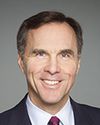Thank you, Mr. Chair.
Before I begin, I'd like to once again thank the members of the committee for their continued work during this particularly challenging period for all of us.
The pandemic continues, obviously, to have serious economic impacts across Canada. For many Canadians, the pandemic has brought about unprecedented uncertainty: uncertainty about their jobs and their financial security and uncertainty about making ends meet.
Today marks three months since the Prime Minister announced the first elements of Canada's COVID-19 response plan. From the very beginning, we've maintained an unwavering commitment to supporting Canadian households and businesses. We've rolled out measures for workers and businesses across all sectors and for employers of all sizes. We've worked and are continuing to work closely with local, provincial, territorial and indigenous partners to minimize the health, economic and social impacts of COVID-19.
Now, three months into the crisis, there are some encouraging signs in Canada that the spread of the virus is slowing down. Many provinces and territories in Canada are beginning to cautiously reopen their economies, something that the finance ministers are telling me in my weekly calls is really beginning across the country, but we're not out of the woods yet. COVID-19 continues to pose significant risks to Canadians and, of course, to our economy.
That is why our government continues to take action to reduce the impact of COVID-19. Our goals remain the same: to protect Canadians, support Canadian workers and businesses, and support our communities to ensure that Canada is ready to bounce back when we emerge from this crisis.
I'd like to highlight some of the measures we've recently announced.
Earlier this month, the Prime Minister announced that funding for the federal gas tax fund has been brought forward this year. The gas tax fund is a permanent source of funding that is provided to the provinces and territories. The provinces and territories then disburse the money to municipalities to support various local priorities.
Usually, the federal government transfers the money in two instalments, one during the summer and the other a few months later. We know that this year the municipalities need the money now so that they can deal with the crisis caused by COVID-19.
In the next few weeks, $2.2 billion from the federal gas tax fund will go to Canadian municipalities: money that will help municipalities move forward with infrastructure projects that will improve quality of life, help restart local economies and create good jobs. We understand that more will be needed to help municipalities, as many are facing significant COVID-19-related financial pressures, but we know that this is an important first step. We'll keep working with provinces and territories in order to help support municipalities.
As the provinces and territories gradually get their economies back on track, our top priority remains protecting the health of Canadians. That is why we have begun negotiations with our provincial and territorial counterparts to ensure that any reopening takes place while protecting the health of Canadians and minimizing the risk of transmission of the virus.
In particular, we are working with the provinces and territories to ensure that all Canadians can have paid sick days. People need to be able to stay home if they have symptoms of COVID-19 without worrying about how they're going to pay their bills.
We also continue to ship equipment across the country, such as surgical masks and gloves, and provide support to the provinces and territories in testing for COVID-19.
As we continue our discussions with our provincial counterparts to make sure Canadians can get back to work safely, we'll also be focused on the following areas: testing and contact tracing; making sure there is personal protective equipment, so Canadians are safe on the job; support for child care; support for vulnerable people, like those in long-term care facilities; and support for cities and municipalities. We know we all need to work together.
Throughout the pandemic, one thing has been clear: we've all been touched by this crisis.
Last week, the Prime Minister announced that seniors eligible for old-age security in the guaranteed income supplement will receive their special one-time tax-free payment during the week of July 6. Seniors eligible for the OAS pension will receive a payment of $300. Those eligible for the GIS, who are the most vulnerable, will receive an additional $200.
The pandemic has also heightened and highlighted the additional challenges already facing indigenous peoples in our country. We're working with first nations, Inuit and Métis communities to address their specific needs. Since we last met, our government has announced additional funding to support indigenous peoples. This includes an additional $75 million in supports for organizations that provide services to indigenous people in urban centres and off reserve, and an additional $650 million to support communities on health care, income support and new shelters for women.
This builds on measures already announced to support the public health response in indigenous communities, as well as the support to indigenous businesses and aboriginal financial institutions.
The measures to help Canadians that were recently announced, and which I just mentioned, are in addition to the measures that were previously put in place. These are measures that we continue to improve. For example, we continue to improve the Canada emergency wage subsidy. Last month, we proposed that the program be extended to August 29.
In recent weeks, the government has also held consultations with representatives of business, labour, non-profit organizations and charities. We want to see what improvements can be made to the program. The Canada emergency wage subsidy has already helped more than 2.6 million Canadians keep or return to their jobs.
The key objectives of any potential changes to the Canada emergency wage subsidy would be to maximize employment to ensure that the program reflects the immediate needs of employers and to support the post-crisis economic recovery.
Overall, our government's swift and comprehensive actions through the COVID-19 economic response plan are providing more than $150 billion in direct support to Canadians. This, coupled with liquidity support of $85 billion through tax and duty deferrals, represents support equivalent to more than 10% of our GDP. This has put Canada at the forefront of our international peers in the robustness of our response. We've done this because we believe that, by investing in Canadians now, we stand well prepared for success in the economic recovery to come.
While there is reason to be optimistic, we must all continue to take precautions to control the spread of the virus. As provinces, territories, municipalities and businesses begin to gradually reopen, we'll stand ready to support them to make sure Canadians remain safe and supported. Our government will be there with Canadians every step of the way.
I would now be pleased to take questions from the members.





